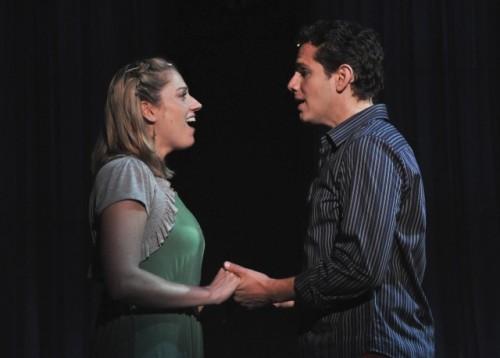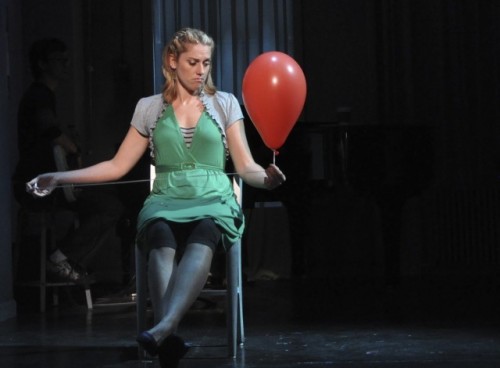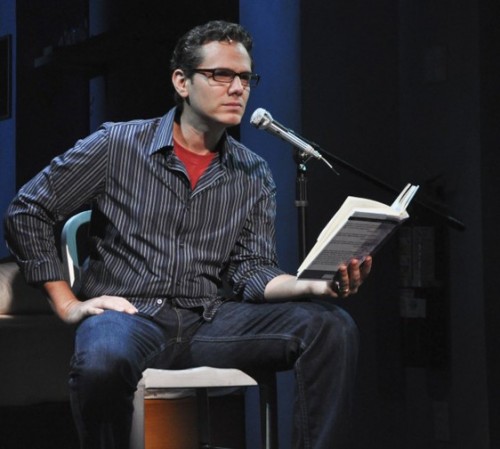The Last Five Years by Jason Robert Brown
Relationship Drawn Out at Berkshire Theatre Festival
By: Charles Giuliano - Jun 27, 2010
The Last Five Years
Written and Composed by Jason Robert Brown
Directed by Anders Cato
Musical Direction by Rick Bertone
Scenic Design, Lee Savage; Costume Design, Laurie Churba Kohn; Lighting Design, Jeff Davis; Sound Design, Janie Bullard; Production Stage Manager, Jason Hindelang; Movement Consultant, Rachael Plaine.
Actors: Paul Anthony Stewart (Jamie Wellerstein) and Julie Reiber (Catherine Hiatt)
Orchestra: Rick Bertone (Piano), William Hack (Bass), Bing Liu (Violin), Johan Thomas (Cello), Evan C.L. Randall (Guitar)
The Berkshire Theatre Festival
Stockbridge, Mass.
June 22 to July 1o, 2010
The Last Five Years by Jason Robert Brown, at the Berkshire Theatre Festival through July 10, is by, about, and for twenty somethings. Some find it charming, lyrical and insightful. It has won major awards and been produced countless times. An increment of the audience on opening night burst to their feet with a standing ovation.
The musical, a series of 14 songs with sparse dialogue, alternates between Jamie Wellerstein (Paul Anthony Stewart) and his wife Catherine Hiatt (Julie Reiber). The trope is that they convey the arc of a failed marriage through alternating time lines over five years. She starts with a breakup song “Still Hurting” while he relates being bored dating Jewish girls and is longing for a “Shiksa Goddess.”
While they share the stage they remain separate. We follow two story lines that converge with the only duet “The Next Ten Minutes” at the exact midpoint of the 90 minute evening. It was a too brief moment that conveyed chemistry between the actors.
Mostly we endure a disconnected narrative with little or now synergy, by design. It begs the question of just how one relates to or cares about an aspiring actress and struggling author. Neither of them conveys enough insight or life experience to become absorbed in their estranged relationship. For this viewer the evening devolved into a he said she said cackameney love story.
There were moments and the audience now and then burst out in applause. Perhaps the women felt for her agony and pathos. The ups and downs of love. The longing to be together. Hope of commitment. While he conveys anger that she is not there for him during his first book signing. Or a guy thing about how, now that he is married, women are coming on to him like never before.
So the actors are literally coming and going while we are asked to keep score. They are ships passing in the night. Or shuffling around their apartment. It would have helped if we could follow the lyrics. They were not always clear particularly in Reiber’s upper register. After the show I heard a patron complain loudly that he could hear only about 60% of the lyrics. I clocked in somewhat better at 80%.
The miserable, drab set by Lee Savage didn’t help. While elaborate, with unexplainable pilasters, it was so boring to look at. There were outside wings on either side of the stage with a box of a room in the middle. It was confining and claustrophobic, intentionally, to convey the deathgrip nature of their relationship. One thought of Sartre’s No Exit where hell is other people. In this case Jamie and Cathy.
There were a couple of props that were shoved about. One was a bed. Another a table. But these accoutrements were used absurdly. While the bed signified the physical aspect of their relationship we never saw them together. Did they ever have sex? He sings about it but mostly his lust for other women. While she conveys his cheating on her.
In one confounding scene he sings to her in bed. About wanting to be with her forever. But the she is a pillow. What? We see Cathy at the back of the stage. We, like they, longed for a bit of erotic contact.
The box within the stage also created blind corners. Seated at an angle we missed entirely one of the five musicians on stage. Program notes identify the individual as a guitarist. Not only did we not see that musician the angle also meant that the five instruments were unevenly projected. In this configuration the grand piano dominated. It became monotonous and all of the arrangements lacked texture and variety. The arrangement for piano, electric bass, violin, cello and guitar was literally meant to play on our heart strings. It left me feeling strung out. How about a touch of brass or a throaty reed?
Critics have compared the composer Stewart to Stephen Sondheim. Not. Except that the songs tend to be overbearing and convoluted. If that’s what one means by Sondheim.
For all of their artistic aspirations the characters are rather unremarkable. Perhaps one day their talent may develop. But at this stage of their lives and careers their young wine tasted more like grape juice. Cathy laments being one of some 200 young women showing up for a casting call. We wonder why she got the part. And when Jamie reads from his first published novel it strikes one as an instant remainder.
That Cathy and Jamie seem so ordinary is further exacerbated by the truly dreadful costumes of Laurie Churba Kohn. The green, shapeless, dress of Cathy, over knee length leggings is just bilious. It does noting for her. Astrid informed me that it is indeed the current fashion for young ladies but a bit too last year. Try to convince me that it is chic to make Cathy look like some kind of Granny Smith apple. And Jamie is attired as just a guy in generic t-shirts and shirts with sneakers that seemed designed by Walmart.
As stated previously a segment of the audience found this musical to be utterly charming. Including one of my learned colleagues. Go figure. I sat in a funk while around me people burst to their feet. Rather briefly. But, folks, there is no cheering in the press box. We do this for a living.





